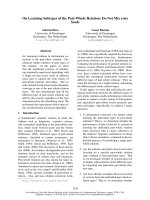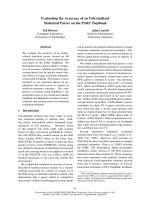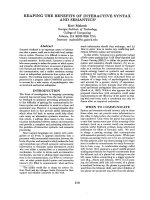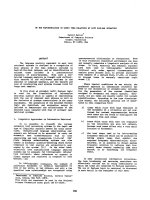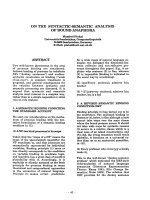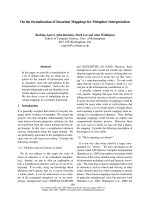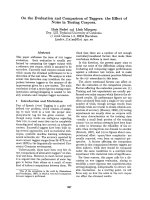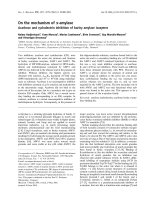Báo cáo khoa học: " On the nature of man and disaster" docx
Bạn đang xem bản rút gọn của tài liệu. Xem và tải ngay bản đầy đủ của tài liệu tại đây (38.05 KB, 3 trang )
Page 1 of 3
(page number not for citation purposes)
Available online />Abstract
Unique among animals, humans survive not by superb physical
adaptation to our environment, but rather by intelligent, large-scale
adaptation of the environment to our needs. We build houses with
climate control systems that mimic the environment of sub-Saharan
Africa. We safely live in environments where the temperature never
rises above freezing and where the level of the sea is higher than
the land we farm and build vast cities upon. We live in tropical
rainforests teeming with hostile organisms, and atop arid, life-poor
mountains and plains, at elevations in excess of 5000 m. As this
editorial is written, a few of us live in space, circling the earth in an
environment of hard vacuum, searing heat, and cryogenic cold. The
sole endowment for our survival that evolution has bestowed upon
us is reason and technologic civilization, which is its product. All
human habitations, and all life on earth for that matter, are under
continuous threat of some kind. Violent weather, earthquakes,
volcanic eruptions, and even meteorite impacts represent threats
of varying degrees of risk.
There is a tide in the affairs of men, which taken at the flood,
leads on to fortune. Omitted, all the voyage of their life is
bound in shallows and in miseries. On such a full sea are we
now afloat. And we must take the current when it serves, or
lose our ventures.
William Shakespeare
“Julius Caesar”
Introduction
Human response to risk can be either proactive or reactive.
Proactive measures include avoiding known risks by not
settling in or venturing into hazardous environments, and
mitigating them by constructing dams, levees, and other
protective infrastructure. Proactive mitigation also includes
creating disaster warning systems, infrastructure to facilitate
rapid evacuation, and emergency shelters in advance of
need. Proactive measures are necessarily costly because
they both consume and sequester resources for an indefinite
period of time. This cost is particularly psychologically
burdensome because it is impossible to predict with any
certainty precisely when a threat will become a crisis or a
disaster.
In contrast, reactive measures are much less expensive in the
short term. Delivering emergency food, water, shelter,
medical care, and post-disaster evacuation have the
theoretical advantage of being deployable anywhere, ideally
from just a few locations. The appeal of post-disaster
response is that the overhead is low and the resources can
be used reliably on a regular basis. Unfortunately, what is not
factored into this approach is the vastly more expensive loss
of property and lives that proactive mitigation would have
prevented. The reasons for disasters such as Hurricane
Katrina can only be understood by inquiring into the nature of
technology and the human minds that wield it.
Timescales
There is an anthropologic perspective on the evolution of
technology. One way to look at this progression is in terms of
timescales. To begin, the ‘trivial timescale’ is bounded by day-
to-day activities such as bathing, unstructured socializing,
and going to work. Humans, and presumably most other
vertebrates, all share this timescale. The second timescale is
the ‘personal timescale’, which allows for planning and
actions that occur over the time course of roughly two human
generations (defined here as 44 years). Such planning
includes selecting and mastering a livelihood, procreating and
rearing children to adulthood, and setting aside resources to
be used in old age and for the benefit of offspring. The
personal timescale stretches the evolutionary limits of the
average human mind. The vast majority of people are
incapable of significant understanding or planning beyond the
personal timescale; indeed, there is little evolutionary reason
for human minds to function in timescales longer than this.
The third timescale is the ‘historical timescale’, which extends
from the present to the beginning of human history. Very few
of us spend any time in this timescale, and the emotional
connection to events going back more than two human
generations is slight. The fourth and most powerful timescale
is the ‘cosmic timescale’, namely the period of time from the
beginning to the end of the universe. Only a microscopic
fraction of humanity has ever ventured into this timescale.
Editorial
On the nature of man and disaster
Mike Darwin
Independent Critical Care Consultant, Ash Fork, Arizona, USA
Corresponding author: Mike Darwin,
Published: 14 December 2005 Critical Care 2006, 10:105 (doi:10.1186/cc3937)
This article is online at />© 2005 BioMed Central Ltd
Page 2 of 3
(page number not for citation purposes)
Critical Care Vol 10 No 1 Darwin
Galileo, Newton, and Einstein exemplify the power of thinking
in the cosmic timescale. They have given us physics and its
daughter sciences. These disciplines have facilitated the
enormous and powerful technologies we now wield, from
splitting the atom to our emerging mastery over the very
fabric of life.
Disaster is largely an artifact in the transition from hunter-
gatherer to town and urban dweller. Homo sapiens began
their relentless advance across the face of the earth about
100,000 years ago [1]. Originally, hunter-gatherers moved,
often cyclically, over comparatively large areas. Agriculture
began to emerge about 12,000 years ago [2], the first human
settlements 11,000 years ago, and the first cities only
7000 years ago [3]. From an evolutionary standpoint this is a
trivial amount of time. The widespread application of the
scientific method and development of the mathematics of
statistics and probability occurred less than 400 years ago –
an evolutionarily insignificant amount of time. Our entry as a
species into the historical and cosmic timescales spawned
both our reliance on technology and our vulnerability to
disaster.
Accordingly, it is likely that disasters will always be part of
human life for at least two reasons: human settlement has
been undertaken in environments where the hazards are not
completely understood; and known hazards are under-
estimated or ignored. History is replete with examples of
both. However, our concern here is primarily with situations in
which people abuse reason and technology and take extreme
risk at great cost in terms of lives and property. Here, history
is perhaps the best teacher, for it is rich in the story of why
catastrophes like Katrina occur.
Pompeii
Nearly 2000 years ago, in 79 AD Pompeii was a thriving
Roman port city on the Bay of Naples. Pompeii and the
surrounding communities of Herculaneum, Stabiae, Oplontis,
Sora, Tora, Taurania, Cossa, and Leucopetra were of roughly
the same character and economic importance to Rome as
are New Orleans, Biloxi, Gulfport, Mobile, Bay St. Louis, and
Slidell to the USA.
Pompeii had been continuously inhabited since it was
founded in the 6th century BC. In 62 AD an earthquake of
large magnitude devastated the city. The damage from the
earthquake was so extensive that 14 years later
reconstruction was still underway, although most of the
residential and business structures had been rebuilt –
apparently on a grander scale than before. Early August in the
year 79 AD the wells in Pompeii ran dry. As August wore on
small earthquakes began to rattle the city. Finally, on the
afternoon of 24 August at about 13:00 hours Mount Vesuvius
erupted. The eruption of Vesuvius darkened the sky and
blanketed the city in ash. Pompeii, much like New Orleans,
was largely evacuated, and like in New Orleans only about
10% of the population (2000 souls) remained in the city for
the final cataclysm. This is remarkable because this eruption
of Vesuvius was the first time in recorded history that a
vertical eruption of this magnitude and its accompanying
pyroclastic flow were documented (by Pliny the Younger [4]).
By the evening of the 24th two additional eruptive surges had
covered the city in 2.5 m of fine ash. This had exactly the
same effect on the remaining population as did the flooding
of New Orleans; it was as impossible to move through the
ash to escape via either land or sea. The residents who
remained were trapped. Between 07:00 and 08:00 hours on
the morning of the 25th, the fourth and fifth eruptive surges
occurred and these were lethal to both the city and its
inhabitants [5]. These surges moved at a rate of
200–300 km/hour, tearing off roofs, fragmenting lighter
structures, and transiently raising the ambient temperature to
over 200°C [6].
Conclusion
So, what is the relevance of Pompeii to our contemporary
response to risks and hazards of similar magnitude? Vesuvius
last erupted in 1944, at which time there was significant loss
of life and property. Since that time the area has been
densely repopulated, and the town of San Sebastiano was
rebuilt on its former site directly atop the lava flow that
destroyed it in 1944! Currently there are 3 million people
living in an area of high risk and approximately 600,000 living
in the ‘zona rosa’, virtually in the same geographic area
occupied by Pompeii, Herculaneum, and their sister
communities [7]. The logistics of the timely evacuation of
3 million people with little or no warning, living at a density
greater than that of the inhabitants of Hong Kong, are
incomprehensible. At this time, engineering to protect the
population at risk should Vesuvius experience another
catastrophic eruption does not exist. Because of the
impossibility of timely evacuation in the event of a sudden
eruption, those who choose to live and work in the shadow of
the volcano today are more likely to lose their lives than were
the inhabitants of Pompeii nearly 2000 years ago. This is a
classic example of people choosing to continue occupying
hazardous zones where effective proactive risk mitigation is
not technologically possible.
There is hope. Proactive, protective technology exists that can
reduce the threat of disaster along the Gulf Coast and
presumably other areas to a negligible or acceptable level and
is in use around the world. The multibillion dollar Deltawerk
seawalls constructed in The Netherlands [8] and the Thames
Barrier in London [9] are examples of the kind of engineering
that could protect New Orleans and other at-risk US cities from
future hurricane storm surges. Radically improved building
codes that mandate structural resistance to high winds and
flying debris, such as those implemented in Florida after
Hurricane Andrew, would greatly reduce the loss of homes and
businesses, even in the face of category 4 hurricanes.
Page 3 of 3
(page number not for citation purposes)
Technologic civilization is now both global and integrated. A
retrovirus infecting a few individuals in a remote corner of
Africa can bloom into a relentless worldwide epidemic [10]. A
disaster half a world away can cripple or potentially even
destroy our increasingly unified technologic civilization. As a
species we must make the jump from the trivial and personal
timescales to the historical and cosmic ones, or we shall
perish. Eleven thousand years ago we made the incredible
jump from hunter-gatherers to agricultural town dwellers. The
wisdom of this decision is challenged with each failure in
foresight that leads on to disaster. From the moment we
began to seek our fortune in the realm of the historical and
cosmic timescales, we embarked on the ultimate voyage. To
quote Shakespeare once again, ‘On such a full sea are we
now afloat. And we must take the current when it serves, or
lose our ventures.’
What will be our choice – on to fortunes or bound in shallows
and miseries?
Competing interests
The author(s) declare that they have no competing interests.
References
1. Pfeiffer JE: The Emergence of Man. New York: Harper & Row;
1969.
2. Price DT, Gebauer AB (editors). Last Hunters-First Farmers: New
Perspectives on the Prehistoric Transition to Agriculture. Chapter 2.
Santa Fe, NM: School of American Research; 1995:39-94.
3. Adams RM: The origin of cities. Sci Am 1994, special issue:12-
19.
4. Radice B: Letters 6.16 and 6.20. In The Letters of Pliny The
Younger. London, UK: Penguin Books Ltd; 1969.
5. Parslow CP: Herculaneum and Pompeii: Rediscovering Antiquity:
Karl Weber and the Excavation of Herculaneum, Pompeii and
Stabiae. Cambridge: Cambridge University Press; 1998.
6. Luongo G, Perrotta A, Scarpati C, De Carolis E, Patricelli G, Ciar-
allo A: Impact of the AD 79 explosive eruption on Pompeii, II.
Causes of death of the inhabitants inferred by stratigraphic
analysis and areal distribution of the human casualties. J Vol-
canol Geothermal Res 2003, 126:169-200.
7. McGuire B: In the shadow of the volcano. The Guardian 2003,
October 16:1-7.
8. Bijker WE: The Oosterschelde Storm Surge Barrier: a test
case for Dutch water technology, management, and politics.
Technol Culture 2002, 43:569-584.
9. Gilbert S, Horner R. The Thames Barrier. London, UK: Thomas
Telford; 1992.
10. Robbins KE, Lemey P, Pybus OG, Jaffe HW, Youngpairoj AS,
Brown TM, Salemi M, Vandamme A, Kalish ML: U.S. Human
immunodeficiency virus type 1 epidemic: date of origin, popu-
lation history, and characterization of early strains. J Virol
2003, 77:6359-6366.
Available online />

